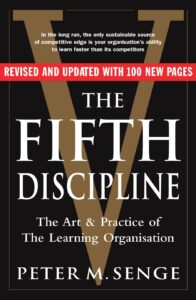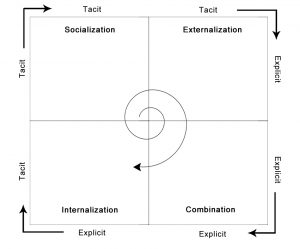
The creation of learning organizations and knowledge management
I took a course called “Training and Development” as an undergraduate, and during one of the classes, the professor mentioned Peter Senge’s book1 The Fifth Discipline: The Art & Practice of The Learning Organization (Figure 1). In this course, the professor emphasizes the importance of building learning organizations and implementing knowledge management in enterprises. It was the first time I learned about the concept of knowledge management and was exposed to the Nonaka’s SECI model2 (Figure 2).

So, what is the connection between knowledge management and the creation of learning organizations? Let’s use the SECI model to analyze the five disciplines proposed by Peter Senge.
The First Discipline: Personal Mastery
Self-transcendence refers to the process in which individuals continuously improve themselves, realize their innermost wishes, and more effectively achieve personal and organizational goals. In the process of self-improvement, individuals need to constantly absorb and create new tacit knowledge through interactions with others. This knowledge is often informal and difficult to encode, residing in personal experience, intuition, and feelings. Consequently, this discipline involves the socialization phase in the SECI model.
The Second Discipline: Improving Mental Models
Mental models refer to our internal view of the world, which influences our behavior. Improving mental models entails recognizing the existence of one’s own mental models and being willing to constantly revise and enhance those models in order to see things more objectively. It also includes improving effective communication skills that balance questioning and expression – effectively expressing one’s own ideas while remaining open to the ideas of others. This discipline involves the socialization and externalization stages of the SECI model, requiring us to observe reality both internally and externally within the organization, communicate with others, and create and share tacit knowledge.
The Third Discipline: Building a Shared Vision
A shared vision is a collective vision of the future that is embraced by the members of the organization and the goals and values established by the team together. This discipline focuses on enabling every member of the organization to participate in the process of building the vision and feel a part of its realization. Conscious creative learning occurs only when people are committed to realizing common ideals, aspirations, and a shared vision. This practice encourages each member to share their tacit knowledge with others in the form of words and diagrams, and then the team integrates these externalized pieces of knowledge through discussion to form a vision that is recognized by all members, thus achieving the externalization and combination of knowledge transformation.
The Fourth Discipline: Team Learning
Team learning refers to the learning ability of a team as a whole. It is not only the sum of individual learning of team members, It is not only the sum of individual learning for team members, but more importantly, through effective communication and collaboration, the entire team can learn and apply new knowledge and skills. This practice involves the externalization, composition, and internalization in the SECI model. Each member converts their hidden knowledge into explicit knowledge and shares it with others through language and writing. The whole team then sorts out this knowledge to form new explicit knowledge through discussion and other means. Finally, each member needs to learn and master the new knowledge in their daily work.
The Fifth Discipline: Systems Thinking
Systems thinking is considered the core of the five disciplines, integrating the theory and practice of the other disciplines into a cohesive framework and strengthening each of them. It is a perspective of looking at the world that emphasizes understanding the interconnectedness and holistic dynamics of things. Through systems thinking, people can better identify complex causal relationships and make more effective decisions. This discipline realizes the combination process of knowledge transformation by combining the own externalized knowledge with the knowledge from others, thinking critically about and understanding the relationships between knowledge, and integrating and forming new explicit knowledge.

Knowledge management and continuous learning
Knowledge management is one of the core functions of a learning organization. On the one hand, knowledge management provides the technical foundation for the operation of learning organizations through a series of models, tools and processes to ensure the effective acquisition, creation, sharing and application of knowledge. On the other hand, the learning organization creates a good environment for knowledge management. This organization shapes a culture and atmosphere of continuous learning in enterprises, employees are encouraged to share their experiences, insights, and findings. This culture of openness and sharing further facilitates the accumulation and application of knowledge.
Learning is a lifelong process. Organizations can never say, “We are already a learning organization,” because the more they learn, the more they become aware of their ignorance. This means that no matter how successful an organization is, there is always room for improvement. Therefore, a company cannot achieve eternal excellence, it must continue to learn in order to improve. As Arie de Geus, former planning director at Shell, says, “The only lasting competitive advantage may be the ability to learn faster than your competitors.”
Therefore, through continuous learning and knowledge accumulation, organizations can better adapt to changes in the external environment, respond quickly to market demands, and maintain competitiveness.
Conclusion
To sum up, creating a learning organization and implementing effective knowledge management are essential for any enterprise that wants to remain invincible in the fierce market competition. By establishing a positive climate for continuous learning and utilizing advanced knowledge management techniques, companies can achieve continuous growth, drive innovation, and ultimately reach higher achievements.
Article source: Adapted from The Creation of Learning Organizations and Knowledge Management prepared as part of the requirements for completion of course KM6304 Knowledge Management Strategies and Policies in the Nanyang Technological University Singapore Master of Science in Knowledge Management (KM).
Header image source: Piqsels.
References:






